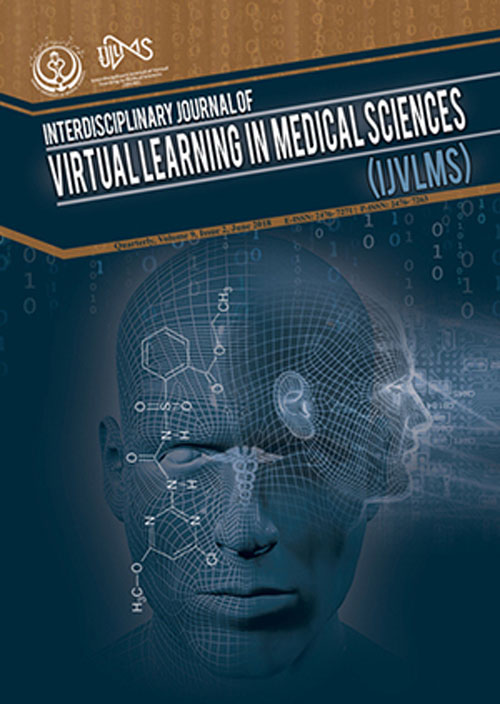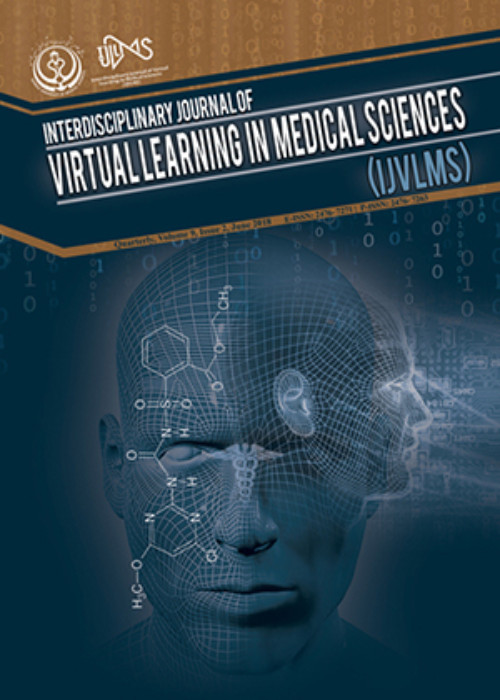فهرست مطالب

Interdisciplinary Journal of Virtual Learning in Medical Sciences
Volume:12 Issue: 2, Jun 2021
- تاریخ انتشار: 1400/03/20
- تعداد عناوین: 9
-
-
Pages 77-84Background
Mindfulness is a psychological process directing an individual’s attention to the experiences in the present moment. Mindfulness-based interventions (MBIs) have been widely studied as a means of improving teaching-learning in educational environments (e.g., schools and universities). The main objective of this study is to determine the effectiveness of MBIs on students’ academic achievement in schools or universities. Additionally, the present study aims to examine the effect of MBIs on stress reduction, executive function, and working memory performance in educational environments.
MethodsSeveral bibliographic databases such as PubMed, Embase, and Web of Sciences will be searched to find relevant studies with interventional designs. A combined approach using a thesaurus (MeSH and EMTREE) and free-text-based methods will be applied to find the search terms and construct the search syntax. The intervention of interest is any type of MBI, alone or in combination with other cognitive interventions. The control is considered as “no intervention” or “any similar cognitive intervention(s)” such as different teaching-learning processes. The Cochrane Collaboration tool will be used to assess the bias risk in randomized trials for examining the quality of the studies. Effect size measurements such as dppc2, Cohen’s d, and Hedges’ g will be performed.
DiscussionThis review will provide necessary data for examining the effectiveness of MBIs in educational programs. Additionally, by performing subgroup analyses, a comparison between different types of MBIs will be made to find suitable interventions for particular groups of students. Furthermore, the major sources of heterogeneity between the included studies will be investigated.
Keywords: Mindfulness, Mindfulness-based intervention (MBI), Educational research, Selfefficacy, Student empowerment, Blended learning -
Pages 85-96Background
On March 9, 2020, the government of Nepal declared suspension of all academic activities in line with a nationwide lockdown following the COVID-19 outbreak. To keep pace with the academic calendar, medical universities resumed their teaching and learning activities through virtual means on account of nonfeasibility of holding physical classes. The present study sought to identify the perception and experiences of undergraduate medical and nursing students regarding the virtual classrooms.
MethodsWe adopted a sequential explanatory mixed method design whereby data were collected in two phases. Quantitative data were gathered from a survey (n=737) and qualitative data from focused group discussion (n=14). The participants were recruited using a non-probability Peer Esteem Snowballing technique. Quantitative data were analyzed using descriptive and inferential statistics, whereas qualitative data was examined using a narrative thematic analytic approach.
ResultsMean age of participants was 22±2.01 with (81%) female participation. The quantitative findings revealed that the “synchrony” domain had the highest mean score (4.10±0.47) and “course interaction” had the lowest mean score (2.93±0.81) amongst the four domains. The domains were significantly correlated to each other (P=0.01) and (P=0.05). Results from focus group discussion indicated that interactions were lower in the virtual classes and there was a great variation between the learners’ perception and their experiences of virtual classrooms. Students preferred blended classes to be implemented in future sessions.
ConclusionIn spite of various challenges, the students perceived the transition from traditional to virtual classrooms in a positive and enthusiastic way. An effective virtual learning experience requires a modified instructional approach on the part of educators and a consistent attitude from learners.
Keywords: New trend, Physical classes, Suspension, Virtual class, COVID-19 -
Pages 97-105Background
Individuals’ learning habits and associated challenges in medical education have rarely been studied in the present digital era. We investigated if a tailored instructional approach is needed for domestis and international students studying histology.
MethodsThis cross-sectional survey was performed in May 2019 at the Faculty of Medicine and Dentistry of Palacky University in Olomouc, Czech Republic. Census method was applied, and a validated researcher-made questionnaire was distributed among all students attending histology courses. We collected 192 evaluable questionnaires from Czech students and 61 from international students. Differences in opinions between the two groups were tested using Fisher´s exact and chi-square test.
ResultsCompared to their domestic peers, international students were less reliant on printed textbooks (6.9% vs. 17.3%), while showing greater interest in materials from lectures (35.3% vs. 9.2%) (P<0.0001). They were also more inclined to use virtual microscopy only (P<0.0001), and unlike their Czech counterparts, they preferred to study in small groups rather than alone (35.5% vs. 4.7%) (P<0.0001). As for the theoretical knowledge acquired in high school, international students were less prepared than Czech students (P=0.0218). Most international students (62.3%) welcomed preparatory courses aimed at solidifying their knowledge of basic sciences in advance of medical studies. However, no differences in opinions on the use of resources were found between native and non-native English speakers (P=0.6506). Domestic as well as international students experienced very similar problems when studying histology. All students appreciated taking interactive tests to assess their practical and theoretical knowledge.
ConclusionDespite the introduction of modern digital technologies such as a Virtual Microscopy in histology courses, a tailored approach to different groups of students is needed.
Keywords: Histology, Virtual microscopy, E-sources, Tailored teaching approach, Internationalstudents -
Pages 106-116Background
English instructors have faced numerous challenges following the COVID-19 outbreak and the sudden shift from inperson to online instruction. This vogue of alternative teaching practices is presently open to rigorous scrutiny. The current study attempted to shed light on the challenges facing the instructors of English for Academic Purposes (EAP) at medical universities, and their strategies in handling emergency remote teaching during the pandemic.
MethodsA qualitative content analysis was conducted to gather data from self-reflections and semi-structured interviews with 52 EAP instructors working at different Iranian medical universities in the spring and summer of 2020. The contents of the reflections and interviews were coded by the researchers based on the procedures of sequential explanatory strategy, and the major themes were extracted and categorized.
ResultsThe findings point to the lack of required facilities and infrastructure, inadequate technological literacy, and poor internet quality as the major challenges facing the instructors. It was also revealed that the teachers viewed the enhancement of technological literacy and provision of required facilities as the main priorities in addressing the challenges.
ConclusionIt was found that the EAP instructors had different perceptions of emergency remote teaching and potential solutions to the associated challenges. The findings offer practical recommendations for enhancing English proficiency among medical students. The results also highlight the necessity of offering EAP teacher training courses focused on developing the technological literacy of the instructors. To continue this line of research, a more in-depth study of students’ perceptions and experiences of online EAP classes is recommended.
Keywords: COVID-19, English teachers, Online instruction, Reflections, Challenges, Contentanalysis, Qualitative research -
Pages 117-128Background
Being a relatively new learning mode, e-learning offers a comprehensive solution for those institutions seeking to adopt modern technologies and transform their teaching methods and environments. The present study employed Misra and Dhingra model to assess e-learning maturity in the field of agriculture in Iran using artificial neural network.
MethodsThis cross-sectional study was performed based on six levels of Misra and Dhingra model. It was conducted among 340 graduate agriculture students and 177 faculty members at four universities including Bu Ali Sina, Tehran, Hormozgan, and Mashahd universities. The participants were selected based on proportional sampling method from July 1 to September 28, 2019. A validated researcher-made questionnaire was used for data collection, and WEKA software version 3.9.2 was employed for data analysis.
ResultsThe results indicated that the level of academic achievement in the field of agriculture can be predicted based on the Misra and Dhingra model. Furthermore, e-learning was at the fourth level in this field in Iran’s higher education.
ConclusionsIn general, educational facilities and infrastructures were identified to be suitable for e-learning implementation in Iran’s higher education institutions.
Keywords: E-learning, Electronic maturation, Weka software, ANN -
Pages 129-135Background
The COVID-19 pandemic and subsequent lockdowns have contributed to the rise of new digital platforms for online education worldwide. This mode of teaching has its own merits and drawbacks. Yet, it is increasingly recognized as the only viable method of instruction during the pandemic. This study sought to evaluate students’ perceptions of different aspects of online teaching in pandemic times.
MethodsThis cross-sectional study was conducted among 257 undergraduate medical students during October 2020. Their informed consent was obtained, and a validated researcher-made questionnaire with 51 closed-ended items was distributed among them using Google Forms. Data were analyzed using SPSS version 22, and all the statistical tests were conducted at a significance level of 5%.
ResultsFindings revealed that 241 students (93.8%) attended online classes using smartphones, whereas only 4 students (1.6%) used laptops. Most students (n=164, 63.8%) were conversant with the use of internet/online apps (P<0.0001). Also, a majority (n=156, 60.7%) disagreed with the time-saving benefit of online classes, and 29 students (11.3%) argued that live lectures offered greater scope for connection with teachers as compared to online classes. Finally, 209 students (81.3%) believed that they were less attentive in online lectures than in live lectures, and 180 (70.1%) were not willing to attend these lectures after the pandemic.
ConclusionAlthough online teaching is a very powerful and effective means of teaching in this pandemic, it was observed that students were less favorable toward online classes due to nonavailability of books, technical problems and network connectivity issues. It is worth noting that working with live patients in real clinical settings is vital to medical education and cannot be fully replaced by e-learning.
Keywords: Medical students, Questionnaire, Perception, Medical Education, COVID-19 -
Pages 136-141
Wilderness medicine (WM) education is desired in Primary Care Sports Medicine fellowship training. Due to the COVID-19 pandemic and travel restrictions, a virtual wilderness medicine boot camp was created to share a WM experience with learners across the United States. A previously led in-person WM boot camp was converted to lecture format and delivered through video conference. This covered information relevant to WM and the sports medicine certification exam. A post intervention survey was completed by 79.5% of participants (128/161). Participants rated the virtual experience positively. Both fellows and faculty felt the virtual boot camp adequately taught WM topics (fellows [5(4-5)], faculty [5(5- 5)], P<0.01). Both felt the virtual experience was sufficient over an in-person boot camp (fellows [4(2.75-4)], faculty [4(4-5)], P<0.01). Due to the ongoing COVID-19 pandemic, it is important to rethink teaching strategies to optimize the opportunities for learners. To date, this is the largest boot camp recorded in the literature. This was a safe and cost effective way to ensure that requirements for a WM experience were met. This virtual course could be adjusted to fit learning objectives of any specialty and tailored to accommodate any level of learning.
Keywords: Virtual, Boot camp, Wilderness medicine, Education, Primary care sportsmedicine, Survey -
Pages 145-148
The COVID-19 pandemic has had a negative impact on all spheres of social life. This has especially been the case with educational systems, which were evidently unprepared at the outset of the crisis. This commentary examines the challenges of medical education during the pandemic and recommends possible solutions for adapting to the changing trends in this period while providing an outlook on the post-corona challenges. It will also look into the opportunities besides the challenges. The outbreak has created an atmosphere that promotes commitment in education, improves educators’ abilities, enhances the production of virtual content, challenges traditional attitudes and helps with self-directed learning among students. These developments could leave their mark on education well beyond the pandemic. The post-corona era can be an age of transformation characterized by a drastic shift from traditionalism to alternative educational approaches. Accordingly, besides the changes in attitudes, it appears necessary to lay the technological groundwork and identify the associated challenges. New opportunities will arise in the form of more effective technology integration in distance and regular education, enhanced quality of virtual programs and the emergence of new educational trends. These developments are deemed to bring about substantial improvements in the quality of medical education.
Keywords: Medical education, Corona, Post-corona, Challenges, Opportunities


